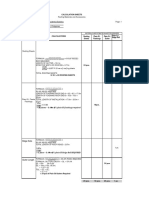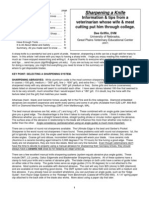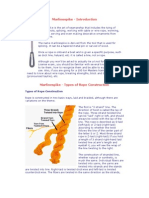Parts of A Knife Handout
Uploaded by
Rose PeresParts of A Knife Handout
Uploaded by
Rose PeresHandout Parts of a Knife
PARTS OF A KNIFE
1. POINT 2. TIP 3. EDGE 4. SPINE
Functions as the piercing tool of the blade Top quarter of blade used for work cutting and separating includes the tip Working part of the blade from point to heel. Top part of blade opposite the edge. Rear part of the edge. Thick band of steel helps balance knife and protect hands. The part of the blade extending into the handle gives knife balance. Parts of the handle that creates the grip. End of the handle
5. HEEL 6. BOLSTER
7. TANG 8. SCALES 9. BUTT
A FEW BASIC RULES
NEVER SOAK A This is bad for the blade and for most handles, KNIFE
especially those made of wood, which can warp. It is also extremely DANGEROUS as someone might put their hands in the water and be cut. The intense heat may ruin the blade as well as other parts of the knife.
NEVER PUT A KNIFE IN THE DISHWASHER If it can bump into NEVER BE something else or fall CARELESS the blades may be ABOUT WHERE damaged. THE KNIFE IS PUT DOWN
Handout Parts of a Knife
STORE YOUR KNIVES WITH THE GUARDS ON NEVER USE THE CUTTING EDGE TO SCRAPE FOOD OFF THE BOARD
This maintains the edges and makes it safer for you when you reach into your kit. Doing so will result in the dulling of the blade.
Handout Parts of a Knife
USE OF YOUR KNIVES:
To correctly hold a knife, centre your grip over the upper handle with thumb and forefinger, gripping the bolster and with three fingers grasped around the handle. This grip maximizes control and leverage and proves to be less tiring during large chopping jobs. After each use, wipe the blade by hand with a damp cloth. Take care to wipe along the spine from the bolster in the direction away from you. NEVER wipe along the cutting edge with the blade pointed toward your hand. Follow by washing the knife in soap and water, rinsing in hot water and sanitizing your blade. Dry immediately.
SHARPENING YOUR KNIVES:
Contrary to common belief, a sharp knife is actually safer than a dull one. The greater force required to counteract the dullness of a blade increases the chance of the knife slipping and cutting the user. A dull knife slashes and tears the food instead of cleanly cutting it. There are many different techniques that can be employed to sharpen your knives with a sharpening stone. You will have the opportunity to learn these from your instructor.
USING A STEEL:
The steel is a tool used more often by a chef than the sharpening stone. The steel should be used frequently to help maintain the edge and should always be used after sharpening the knife on a sharpening stone. The role of the sharpening steel is twofold: 1. To true the edge the action of sharpening the blade on a stone leaves many small teeth on the surface of the blade. While this may aid
Handout Parts of a Knife
somewhat in cutting, it is advantageous to rub the very edge of the blade to perfect smoothness. Also, the blade may bend somewhat during normal usage. The steel, when properly used, will perfect the edge. 2. To remove metal particles after sharpening on a stone your steel is magnetized and this allows the metal particles that result from sharpening to cling to the steel during use which prevents them from getting into food. To clean a sharpening steel, wipe with a cloth that has been dampened with vinegar.
USE AND MAINTENANCE OF KNIVES:
Knives are among the most important tools in food production. A keen edge and the proper shape have so much value for efficient work that many food workers are encouraged to own their own knives and be responsible for keeping them in good condition. The knives used most frequently are the French knife, the Boning knife, the Salad or Utility knife and the Paring knife. ITEM DESCRIPTION Straight-edged blade with firm, tapering point Handle designed so that hand does not interfere when knife is used for chopping Longer than a paring knife Blade is 4-6 inches Cutting edge is straight or curved Blade is from 2 to 3 inches long Comes in sharp, spear and clip points Thin, straight-edged blade with sharp point Curved cutting edge USE Chopping
French Knife
Paring Knife
Utility Knife
Cutting up fruit, large vegetables; slicing meat; any other operation requiring a flexible blade To clean, skin or core fruits and vegetables
Removes bones from meat or fish
Boning Knife
Handout Parts of a Knife
There are other knives in numerous sizes and shapes to fit special purposes such as a grapefruit knife, bread knife, steak knives and clam or oyster knife.
THE CORRECT WAY TO SHARPEN A KNIFE:
After repeated use, knives become dull and lose their edge. Dulling starts when tiny, invisible particles of the edge break off to leave minute dents. Each dent causes a slight jolt as the knife cuts through food. These jolts cause the food to look ragged and hasten the widening of the dents on the knifes edge. To keep knives sharp and their edges smooth, a stone and steel must be used (with a stone you can regrind the blades edge).
Handout Parts of a Knife
If you look straight at the edge of the knife you can see where the two sides of the knife meet. This is the BEVEL. A chefs knife has a 20 degree bevel angle A boning knife has a 30 degree bevel angle Each time you grind the knife a visible amount of metal is removed. The bigger the dents, the more metal you have to remove; however, too much grinding exposes the soft metal interior and ruins the knife. An OILSTONE can have three grit sides: COARSE, MEDIUM and FINE. Oilstones must have lubricating oil on them so the knives can be run across with little resistance (use only Mineral or Machine Oil all other oils cause the stone to pit). Put a damp cloth under the stone to prevent it from sliding. Hold the knife parallel to the stone and perpendicular to your body. Place the heel of the knife at one end of the stone and cutting into the stone with the knifes edge, bring it across to the other end of the stone. (The toe of the knife should now be touching the stone) It is important to hold the knife at the bevel angle when regrinding to maintain the same shape. The first 1/8th inch of the entire knifes edge should have a little oil on it. Repeat from the other side of the stone (twice for each side). Remove oil and grit build-up on the knife with a paper towel. Repeat on medium and fine grit sides. Sharpening on the coarse and medium sides will produce a burr, which is removed by sharpening on the fine side. If you keep a regular schedule of sharpening your knives, you will only have to use the medium and fine sides. Besides, OILSTONES, there are DRYSTONES and WETSTONES. DRYSTONES are thought to be the most durable and are usually shaped into high-speed wheels. The friction caused by the wheel grinding the knife may result in overheating which will soften it. WETSTONES are cut from natural stones and must be kept wet when in use.
USING A STEEL:
Handout Parts of a Knife
The stone should be used every day depending on the need; however, a steel should be used frequently every day. Once, sharpened, the steel will keep the knife sharper longer.
Handout Parts of a Knife
There are many ways to use a steel. The main points are: 1. Keep the knife the same angle you used to sharpen it so that you maintain the edge you put on the knife. 2. To keep your knives sharp use the steel two to three times or more each day. 3. The steel has a safety guard keep your hands above that! It also has a magnetic tip at the end. The tip will pick up any steel burrs from the sharpening. 4. Place sharpening steel point down on a table or cutting board keeping the sharpening steel in a vertical position. 5. Establish an angle between the cutting blade edge and the sharpening steel of approximately 20 degrees. 6. Pull knife down and across the sharpening steel in a slight arc. Repeat on the other side of the sharpening steel. Repeat this process five to ten times, always alternating the left and right sides of the cutting edge.
THE CORRECT WAY TO USE A KNIFE:
REMEMBER: Use of a dull knife usually results in Poor appearance of the food product Poor uniformity and portion control Waste of energy Loss of time Poses a serious safety hazard
When using a dull knife greater force is required which reduces control. THE FRENCH KNIFE: BASIC GRIP 1. Place the cutting edge of the knife on the board holding the knife by the back of the blade with your left hand. 2. Place your right hand on the handle of the knife. 3. The inside of the hand at the base of the index finger should rest slightly above the handle. 4. Close your hand around the handle you may release your left hand from the knife. 5. The handle should be directly under your wrist in a straight line with your forearm. IMPORTANT!
Handout Parts of a Knife
This grip is for the French knife only. In using slicing knives, roast beef knives, boning knives, etc. the grip is on the handle only though oyster and clam knives and paring knives require hand and blade contact. The French knife is the only major tool that requires this specific type of control and support and provides a measure of safety by having a portion of your hand on the blade. What provides a safety measure here might prove a danger with other knives.
Handout Parts of a Knife
POSITION: 1. Stand straight but relaxed, with your weight evenly distributed on both feet. 2. Stand as close to the counter as possible but do not touch it with your body. 3. Place your feet at a 20-degree angle with heels about 5 to6 inches apart. Adjust your stance for comfort. GUIDING HAND: The left hand (for right-handed people) is the hand, which guides and controls the path of the knife. The right hand holds the knife and controls the swing or chop but it follows the direction of the guide hand. 1. Your left hand should be held in the roll position with fingers curled. Bend your thumb toward your hand for maximum protection. 2. To provide a riding surface for the blade of the knife, the knife blade must ride flat and flush against one or more of the middle fingers. As long as the knife blade is held flat and flush against the fingers and is not raised higher than the knuckle of the second joint and you keep your finger tips curled under there is little danger of cutting yourself. REMEMBER! Any tool may become dangerous when you cease to treat it with respect.
Handout Parts of a Knife
The diagrams may be used for actual measurements.
JULIENNE
MINCED
BRUNOISE
SMALL DICE
MEDIUM DICE
LARGE DICE
Handout Parts of a Knife
You might also like
- Collecting Antique Walking Sticks and Canes100% (1)Collecting Antique Walking Sticks and Canes9 pages
- Thomas R Bender A California Knife MakerNo ratings yetThomas R Bender A California Knife Maker6 pages
- 3rd Q L3 - HORTICULTURE Farm Tools and Their UsesNo ratings yet3rd Q L3 - HORTICULTURE Farm Tools and Their Uses32 pages
- 8 Different Types of Metal Cutting Tools and Their UsesNo ratings yet8 Different Types of Metal Cutting Tools and Their Uses31 pages
- Marlinespike - Introduction: Types of Rope Construction100% (1)Marlinespike - Introduction: Types of Rope Construction23 pages
- Oelslager, R.W. - Bushcraft Scouting and Woodlore NotesNo ratings yetOelslager, R.W. - Bushcraft Scouting and Woodlore Notes304 pages
- USDA - Chain and Crosscut Saw Student's Training GuidebookNo ratings yetUSDA - Chain and Crosscut Saw Student's Training Guidebook99 pages
- The Gently Curled Fingers of Your Guide HandNo ratings yetThe Gently Curled Fingers of Your Guide Hand7 pages
- Beginner's Guide to Sharpening Carving Tools: Learn to Keep Your Knives, Gouges & V-Tools in Tip-Top ShapeFrom EverandBeginner's Guide to Sharpening Carving Tools: Learn to Keep Your Knives, Gouges & V-Tools in Tip-Top ShapeNo ratings yet
- Determining Portion Costs and Selling Prices: Key Terms ObjectivesNo ratings yetDetermining Portion Costs and Selling Prices: Key Terms Objectives24 pages
- Variance Analysis: The Budget As An Evaluation ToolNo ratings yetVariance Analysis: The Budget As An Evaluation Tool6 pages
- So You Wanna Build A Casket - Northwoods Casket CompanyNo ratings yetSo You Wanna Build A Casket - Northwoods Casket Company15 pages
- ME303 Machine Tools and Digital Manufacturing PreviousQpsNo ratings yetME303 Machine Tools and Digital Manufacturing PreviousQps2 pages
- Machine Shop Technology II: Introduction To Machine Tool Safety 1.1. Safety Precautions100% (1)Machine Shop Technology II: Introduction To Machine Tool Safety 1.1. Safety Precautions5 pages
- ### Nine Motor Boats and How To Build Them 1913No ratings yet### Nine Motor Boats and How To Build Them 1913136 pages
- Report Politeknik Brickwork Stretcher BondNo ratings yetReport Politeknik Brickwork Stretcher Bond7 pages





























































































